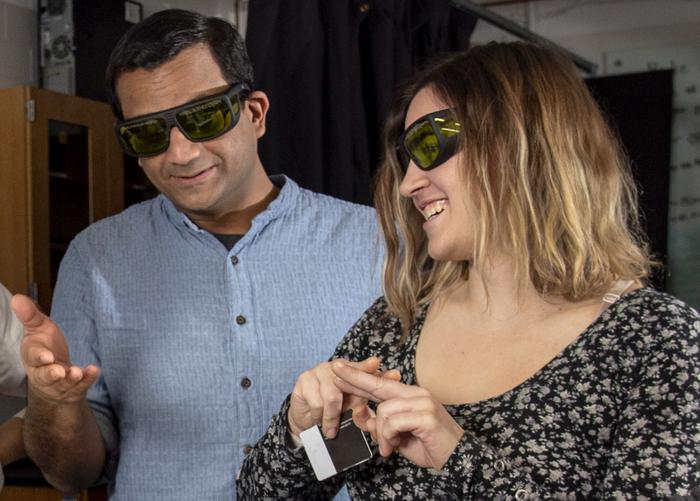Topological insulators (TIs) represent a groundbreaking frontier in condensed matter physics, challenging our understanding of materials by exhibiting unique electronic properties. The remarkable feature of TIs is their ability to conduct electricity on their surfaces while remaining insulating in their interiors. This dual functionality has precipitated intense interest in their potential applications in next-generation electronics and quantum computing. Researchers aim to harness these properties to create energy-efficient devices and advance quantum technologies, which could revolutionize the way we approach computation and information processing.
A recent study helmed by Professor Fahad Mahmood of the University of Illinois has unveiled significant findings regarding magnetically intrinsic topological insulators, particularly focusing on manganese bismuth telluride (MnBi₂Te₄). This research not only sheds light on the band structure and electronic properties of MnBi₂Te₄ but also contests previous assertions regarding its electronic band gap, a contentious issue in the scientific community. The team’s findings mark the first demonstration of how external factors, specifically circularly polarized light, can manipulate the material’s properties in meaningful ways.
Diving deeper into the quantum characteristics of materials, this study elucidates the concept of a hidden gap in the electronic band structure of MnBi₂Te₄ under specific light conditions. While previous studies laid the groundwork, experimental evidence remained elusive, until now. The research clearly illustrates that MnBi₂Te₄ exhibits a gapless condition at equilibrium—an observation consistent with some prior studies—yet intriguingly develops a gap when subjected to different orientations of circularly polarized light.
Through rigorous experimentation, the research team employed angle-resolved photoemission spectroscopy (ARPES) to meticulously examine the band structure of MnBi₂Te₄. This technique detects the electron energies emitted when light shines upon a material’s surface and reveals how these energy levels shift under various external conditions. The intricacies of examining the electronic structure facilitate a comprehensive understanding of a material’s behavior, which is pivotal in describing its physical properties.
A defining characteristic of non-magnetic topological insulators is the adherence to time-reversal symmetry (TRS), a principle asserting that the fundamental laws of physics remain unchanged when time is reversed. For non-magnetic TIs, the electron currents exhibit this symmetry, which grants them their remarkable surface conduction properties. However, in breaking TRS, magnetic topological insulators introduce new quantum phases—one that could potentially yield transformative results for modern technology.
Magnetic topological insulators challenge the conventional understanding of TIs. Unlike their non-magnetic counterparts, the introduction of intrinsic magnetism allows for novel phenomena, such as the quantum anomalous Hall effect (QAHE), which appears when TRS is disrupted. The QAHE facilitates specific energy states that permit currents to flow with minimal resistance—an invaluable property for creating energy-efficient electronic devices. Yet, the inherent challenge is that these magnetic states are typically achieved through external magnetic fields, complicating their practicality for widespread adoption.
Professor Mahmood and his team grappled with the longstanding debate surrounding the existence of a band gap in MnBi₂Te₄. While some experimental research indicated observable gaps, conflicting studies cast doubt on these findings. In their endeavor to clarify this scientific ambiguity, the team utilized Floquet-Bloch manipulation—a state of the art technique that harnesses light to alter material properties and induce new quantum behaviors. By meticulously applying circularly polarized light to MnBi₂Te₄, the researchers successfully induced a band gap, delivering compelling evidence that aligns with theoretical predictions.
The results indicated a striking asymmetry between the responses of the material under right-circularly polarized (RCP) and left-circularly polarized (LCP) light. In the antiferromagnetic low-temperature phase, RCP light opened a gap that was nearly double the size induced by LCP light. This discrepancy in gap sizes robustly signifies the breaking of TRS. The research effectively establishes that altering the direction of light not only influences electron behavior but also has practical implications for the manipulation of quantum states.
Key to these findings is the ability to explore the electronic structure of materials through manipulation techniques such as Floquet-Bloch engineering. By applying these advanced methodologies, scientists now have a tangible way to influence the electronic properties of TIs without relying on cumbersome external fields, leading to more manageable experimental conditions. This breakthrough opens doors to further studies on varied materials and promises an expanded understanding of the mechanisms underlying quantum matter.
As the research progresses, there remains a wealth of uncharted territory awaiting exploration, particularly regarding the broader implications of manipulating magnetic TIs using advanced light techniques. The variations in band gaps identified by the research team not only highlight the interplay between magnetism and electronic states but also raise questions about the underlying mechanisms driving these behaviors.
In the pursuit of deeper insights into MnBi₂Te₄ and similar materials, the potential for real-world applications in electronic devices and quantum computing remains tantalizingly close. By deciphering the complex interactions within these systems, researchers hope to design and develop innovative technologies that could meet the growing demands of modern electronic systems.
The implications of this work extend far beyond the immediate study, as magnetic TIs like MnBi₂Te₄ promise to revolutionize the landscape of condensed matter physics and materials science. Understanding the roles of intrinsic properties like magnetism in determining material behavior sets the stage for potential breakthroughs that could lead to the next generation of electronics, emphasizing the significance of continued exploration in this exciting field.
Lastly, the findings are supported by significant federal grants and institutional support, highlighting the importance of collaborative efforts in driving forward scientific inquiry. As researchers continue to delve into the mysteries of topological insulators, the promise of uncovering further revolutionary discoveries in the physics of condensed matter remains vibrant.
Subject of Research: The hidden gap in the electronic band structure of manganese bismuth telluride (MnBi₂Te₄)
Article Title: Floquet–Bloch manipulation of the Dirac gap in a topological antiferromagnet
News Publication Date: 21-Jan-2025
Web References: https://doi.org/10.1038/s41567-024-02769-6
References: Nature Physics journal
Image Credits: Photo by Heather Coit, Illinois Grainger Engineering
Keywords
1. Topological insulators
2. Quantum anomalous Hall effect
3. Circularly polarized light
4. Manganese bismuth telluride
5. Floquet-Bloch manipulation
6. Electron band structure
7. Time-reversal symmetry




